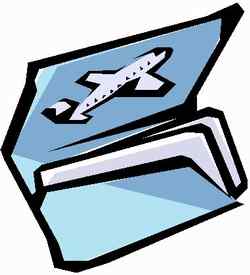Mon, Dec 10, 2007
Electronic Boarding Pass A Sign Of The Times
 Passengers no longer have to dig for
the paper ticket, or worry about where they put their boarding
passes before checking in for a flight. Continental Airlines and
the Transportation Security Administration launched a program to
test using electronic boarding passes on PDAs or cell phones. The
first of it kind boarding pass offered by a US airline is called
the 'Paperless Boarding Pass' pilot program and was kicked off in
Houston, Texas.
Passengers no longer have to dig for
the paper ticket, or worry about where they put their boarding
passes before checking in for a flight. Continental Airlines and
the Transportation Security Administration launched a program to
test using electronic boarding passes on PDAs or cell phones. The
first of it kind boarding pass offered by a US airline is called
the 'Paperless Boarding Pass' pilot program and was kicked off in
Houston, Texas.
The program works like this -- passengers receive boarding
passes on their cell phone or PDA, and are then scanned by TSA
security officers-the paperless boarding passes contain a
two-dimensional bar code that identifies the passenger with their
flight information. The benefit of the electronic boarding pass is,
first, it eliminates the need for a paper boarding pass. Second,
the technology will cut down on passenger fraud. Third, it will
improve customer service and speed up the boarding process.
"The deployment of the paperless technology signifies the TSA's
ongoing commitment to develop and execute new technologies within
aviation while enhancing security," said Mel Carraway, TSA's
general manager for field operations, in a statement. The airlines
and TSA worked together to develop the strategy to use the
paperless process.
 TSA created the paperless scan
process; Continental Airlines came up with a plan for encrypting
the boarding passes on mobile devices. It's not certain that the
program will be used elsewhere, but TSA has expressed interest in
expanding the use of encrypted bar codes.
TSA created the paperless scan
process; Continental Airlines came up with a plan for encrypting
the boarding passes on mobile devices. It's not certain that the
program will be used elsewhere, but TSA has expressed interest in
expanding the use of encrypted bar codes.
In October, the International Air Transport Association
introduced a global standard in October that lays the ground work
for a check-in procedure using cell phones, smartphones, or PDAs
and two-dimensional bar codes. The standard for a two-dimensional
paper bar coded pass was developed in 2005, and is currently used
for Web check-in.
By 2010 all airlines must use bar coded boarding passes,
removing the need for the magnetic strip technology saving he
airlines $500 million a year. Using bar-code--or mobile
electronic--the goal is to get the airlines globally to use one or
the other.
More News
Ground Stop (GS) The GS is a process that requires aircraft that meet a specific criteria to remain on the ground. The criteria may be airport specific, airspace specific, or equip>[...]
Aero Linx: Australian Transport Safety Bureau (ATSB) The Australian Transport Safety Bureau (ATSB) improves safety and public confidence in aviation, marine and rail transport thro>[...]
“The Palo Alto stopover confirmed—yet again—that flight schools and aero-clubs are no longer just curious about electric training; they are ready to buy. In just >[...]
Pilot’s Failure To Maintain Clearance From The Water While Flying At A Low Altitude Analysis: The flight of two airplanes was in cruise flight on a north heading about 50 ft >[...]
Also: 48th Annual Air Race Classic, Hot Air Balloon Fire, FAA v Banning 100LL, Complete Remote Pilot The news Piper PA-18 Super Cub owners have been waiting for has finally arrived>[...]
 ANN's Daily Aero-Term (06.30.25): Ground Stop (GS)
ANN's Daily Aero-Term (06.30.25): Ground Stop (GS) ANN's Daily Aero-Linx (06.30.25)
ANN's Daily Aero-Linx (06.30.25) Aero-News: Quote of the Day (06.30.25)
Aero-News: Quote of the Day (06.30.25) NTSB Final Report: ICON A5
NTSB Final Report: ICON A5 Airborne Affordable Flyers 06.26.25: PA18 Upgrades, Delta Force, Rhinebeck
Airborne Affordable Flyers 06.26.25: PA18 Upgrades, Delta Force, Rhinebeck




